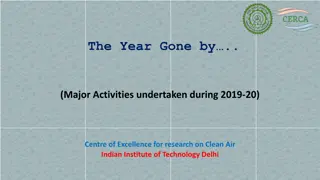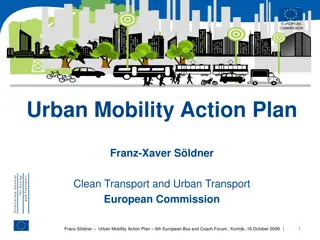Advancements in Air Pollution Prediction Models for Urban Centers
Efficient air pollution monitoring and prediction models are essential due to the increasing urbanization trend. This research aims to develop novel attention-based long-short term memory models for accurate air pollution prediction. By leveraging machine learning and deep learning approaches, the study seeks to provide effective solutions for monitoring and predicting air pollution levels, with a focus on high-risk areas like Skopje. The research also emphasizes the importance of comprehensive research and innovative model design to address the critical issue of air pollution in urban environments.
Download Presentation

Please find below an Image/Link to download the presentation.
The content on the website is provided AS IS for your information and personal use only. It may not be sold, licensed, or shared on other websites without obtaining consent from the author.If you encounter any issues during the download, it is possible that the publisher has removed the file from their server.
You are allowed to download the files provided on this website for personal or commercial use, subject to the condition that they are used lawfully. All files are the property of their respective owners.
The content on the website is provided AS IS for your information and personal use only. It may not be sold, licensed, or shared on other websites without obtaining consent from the author.
E N D
Presentation Transcript
Jovan Kalajdjieski Georgina Mirceva Slobodan Kalajdziski ATTENTION MODELS FOR PM2.5 PREDICTION 7th IEEE/ACM International Conference on Big Data Computing, Applications and Technologies
AIR POLLUTION By 2050 70% of the world's population will live in urban centers, which means that we need efficient solutions for monitoring and predicting air pollution Main cause of death for children under the age of 15, killing 600,000 every year North America and Australia are the least polluted regions, followed by Central Europe, and India and Asia with the highest air pollution Air pollution contributes toward 7 million deaths a year and 92% of the world s population is breathing toxic air
AIR POLLUTION IN SKOPJE Frequently given the title the most polluted city in Europe Natural predisposition contributes towards pollution, but human negligence is a far more influential factor Main source of air pollutants (around 77%) are combustion processes, followed by transportation (around 14%) and production processes (around 6.5%) A more comprehensive research is required to find a reliable and effective solution
AIR POLLUTION MONITORING SYSTEMS Many attempt to employ air pollution monitoring systems Mainly implemented using Internet of Things (IoT) architectures Consisting of multiple sensors connected wirelessly to monitor the different air pollutants in different regions Can be used to extract deeper knowledge for pollution
AIR POLLUTION PREDICTION SYSTEMS Predict the air quality index, the amount of each pollutant and high pollution areas Approaches generally can be classified into two types: Models for tracking the generation, dispersion and transmission process of pollutants Statistical learning models, machine learning and deep learning models
AIM OF RESEARCH Provide novel attention based long-short term memory models for air pollution prediction Provide a comprehensive explanation of our models and design decisions Show and compare our results to the Long-short term memory model (LSTM) and Bidirectional LSTM as a state-of- the-art approaches
DATA Pollution data and weather information for the last three years in Skopje are incorporated Pollution data was collected from the API endpoints of pulse.eco Weather information was collected from the API endpoints of World Weather Online The dataset consists of 563,496 PM2.5 pollution entries fused with the previously stated weather information
PROPOSED APPROACHES The novel approaches are mainly focused on deep learning architectures, specifically recurrent neural networks The pollution data has temporal dependencies which means that the current pollution is dependent on the data available for the previous N timesteps the neural network can decide which available information should be considered, and the appropriate factor for that information How to determine the factor by which different timesteps affect the current prediction, and the window size of the timesteps? In our novel models, we propose an attention approach which resolves the problem of determining how much different timesteps affect the current prediction We show that the size of the window becomes a trade-off with the computational power
STACKED ATTENTION MODEL This model consists of three main building blocks: Pre-attention LSTM block Attention block Post-attention LSTM block
BIDIRECTIONAL STACKED ATTENTION MODEL This model consists of three main building blocks: Pre-attention LSTM block Attention block Post-attention LSTM block
Allows the model to give different weights or pay different attention to the timesteps used to predict the current pollution value We employ a new architecture which allows the model to learn the factors of influence at the different timesteps ATTENTION MECHANISM
EXPERIMENTAL SETUP To be able to evaluate and compare our novel models, we recreated the state-of-the-art Bidirectional LSTM networks LSTM and We experimented with different number of stacked layers of these models, but found that 2 stacked layers work the best, because of the data complexity We have implemented two variations of the two novel models explained in this paper, namely AM with one layer, SAM with two layers, BAM with one layer and BSAM with two layers
Models Stacked LSTM Bidirectional Stacked LSTM Attention Model Stacked Attention Model Bidirectional Attention Model Training MSE Testing MSE 4.91 4.15 4.17 3.65 3.73 8.92 7.22 7.13 4.57 5.52 Bidirectional Stacked Attention Model 1.98 3.41 EVALUATION
CONCLUSION Our models, even though clearly outperforming the state-of-the-art models, can be further optimized High MSE can be explained by the fact that many of the sensors had long downtime, so using a simple imputation is not a desirable technique These models can be extended to predict multiple pollutants, as well as the AQI
THANK YOU FOR YOUR ATTENTION























